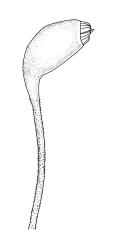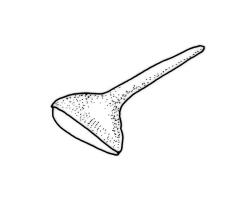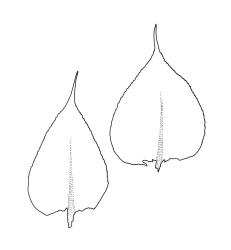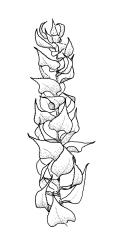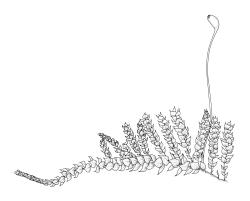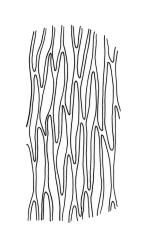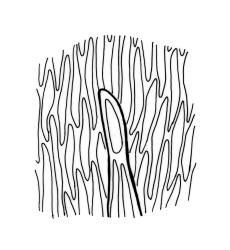- ≡ Hypnum asperipes Mitt. in Wilson, Bot. Antarct. Voy. III. (Fl. Tasman.) Part II, 209 (1859)
Plants yellow-green, lustrous, ascendant, very neat in appearance, forming dense wefts. Stems densely and subpinnately branched, terete. Branches mostly c. 5–12 mm, terete. Stem and branch leaves contorted, usually incurved above, weakly plicate and often ± twisted when dry, wide-spreading and with the apices usually nearly parallel to the stem/branch when moist, differing only by size. Stem leaves very broadly ovate-cordate, moderately concave, strongly narrowed to insertion, abruptly and finely acuminate, not or only weakly plicate, weakly decurrent, c. 1.8–2.2 × c. 1.2 mm, sharply serrulate nearly to base; mid laminal cells linear-rhombic, firm-walled, smooth or very weakly prorate at upper end, mostly 60–85 × c. 9 µm; cells of the acumen scarcely shorter, the terminal cell c. 60–65 µm; alar cells not differentiated. Branch leaves smaller, mostly (0.8–)1.2–1.5 × (0.5–)0.72–1.0 mm, otherwise not differentiated. Costa mostly single, extending c. ½ the leaf length (including the acumen), tapered above, ending in an abaxial spine; sometimes forked at base and shorter in some stem leaves.
Autoicous, but perigonia often difficult to locate. Perichaetia scattered on main stem, the leaves apparently ecostate, widely spreading. Perigonia scattered on stem, c. 1 mm, leaves widely spreading, ecostate and nearly entire, with filiform paraphyses. Setae rather stout, flexuose, 10–17(–25) mm, red-brown, coarsely and densely papillose throughout; capsules curved and asymmetric, short oblong-cylindric, narrowed below mouth when dry, strongly inclined to horizontal, (1.6–)1.8–2.5 mm; exothecial cells rounded-oblong, thick-walled, sometimes weakly thickened in corners; stomata few, restricted to capsule base; annulus present; operculum long rostrate, ± equal the capsule in length. Exostome teeth yellow-brown, lanceolate and shouldered, weakly bordered, transversely striate on the outer surface, trabeculate on the inner surface, c. 500 µm long; endostome from a high membrane, with segments perforate or gaping and nearly the height of teeth; cilia 2–3, well-developed and nodose. Calyptra cucullate and smooth. Spores 11–15 µm, green, smooth.
Wilson 1859, pl. 176, fig. 4; Beever et al. 1992, fig. 78 i; Hedenäs 2002, fig. 7 f; Malcolm & Malcolm 2003, p. 28.
The leaves here have their apices pointed toward the branch apex and nearly parallel to the stem when moist; their abruptly narrowed apex and cordate base combine to give this species a highly distinctive facies. Eurhynchium asperipes is an extremely handsome moss that bears a strong resemblance when fresh to a miniature Ptychomnion aciculare. Size alone, and the clearly brachytheciaceous capsules, preclude any possibility of confusion. The autoicous sexuality and the relatively delicate costae of the branch leaves make this species anomalous in Eurhynchium.
This species bears considerable superficial resemblance to, and occupies similar habitats to, Ctenidium pubescens, but the present species is generally a coarser and less feathery plant. The single costa and papillose seta in the present species are clearly visible with a hand-lens and are among several features that readily distinguish the two.
NI: N Auckland (Te Whau, Bay of Islands, Kepa Bush Reserve), S Auckland, Gisborne (Lake Waikaremoana), Hawke's Bay, Taranaki (Mt Taranaki, near Uruti), Wellington (Ōhakune, Oroua Valley, Tararua Range, Trentham); SI: Nelson, Marlborough, Canterbury, Westland (Ōtira, Lake Kaniere, Fox Glacier), Otago, Southland.
Australasian. Tasmania* Reported from Victoria by Hedenäs (2002) and from N.S.W. and Queensland by Scott & Stone (1976, p. 427).
On a range of terrestrial substrates including humus, damp gravel, and rotten logs in a variety of forest and scrub types, including southern beech forest, on tree bases, soil over rock (greywacke, basalt, limestone, concrete, magnesite); very occasionally as an epiphyte. On the North I. from near sea level (Kepa Bush Reserve) to 1070 m (Mt Taranaki), and on the South I. from near sea level to c. 1220 m (Mt Owen, Nelson L.D.). Common associates of this highly adaptable species include Achrophyllum dentatum, Atrichum androgynum, Brachythecium paradoxum, B. rutabulum, Ditrichum difficile, Eurhynchium praelongum, Fissidens taxifolius, Leptotheca gaudichaudii, Pyrrhobryum bifarium, Rhynchostegium muriculatum, and R. laxatum.



